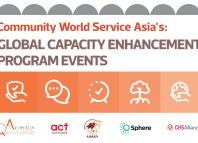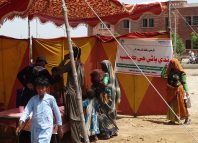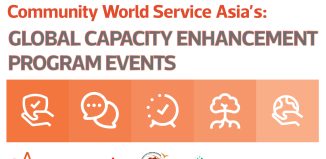The Floods: Through the eyes of an observer
Written by Neill Garvie
Yesterday, with my Pakistani colleagues, I visited the river banks/bunds of the Indus River in Ghotki, Qadirpur, Upper Sindh, where more than 5,000 families are stranded. The day was hot, maybe 40 degrees or more, with harsh sun and wind.
The stranded people are small-scale farmers reliant on their landlords and mostly indebted to money lenders. Their lives are hard, now made impossible. They had left their homes in the middle of the night as flood waters consumed their homes, taking their livestock, buffaloes and cattle.
Some men had stayed behind to protect what was left: submerged houses surrounded by stinking rank water, black and green, with all sorts of debris around. They burned tree stems cut for firewood to enable them to boil the water from the flood to drink.
The women had moved further along the bund (embankment or levee) with their children and what household items they had, their simple cooking utensils laid out on the riverbank. They had no privacy, no toilets, nothing. Many have no shelter except for their clothes and some sheets for protection from the baking heat.
Men sat looking helpless and in their eyes I saw bewilderment and sadness; what could be their next move but to wait? I sat with a group of men my own age, looking tired and haggard. They told me that they had been reduced to drinking the flood water.
We looked out at the sea of flood which stretched as far as I could see; it could be weeks before the water subsides as the ground is saturated.
I listened to the people on the bund and put myself in their shoes. I held back my tears and said that I was so very sorry that this had happened to them again. They are very poor people without hope, fearing what lies ahead.
They are the same people who suffered in the 2010 floods. The water level here is just one foot lower than it was at the height of the 2010 floods and more flood water is expected in the next two or three days.
Children however played in the flood water, sharing it with the buffalo that are defecating in it. Sugar cane and all other crops have been wiped out and standpipes and water pumps are now submerged by over nine feet of flood water.
People have no option but to drink the flood water option unless they can find water or someone can provide it. Disease, diarrhoea or cholera threatens. Cattle do not have fodder. It’s desperate and chilling.
The Pakistan army has been protecting and fortifying the bund where people were stranded with huge rocks, many transported in tractors and overladen trailers. One tractor and trailer was so heavy that it destroyed a bridge designed for donkey carts.
But the flood water is seeping through the bund and the added rocks may not do much to stop more flood water. It will come, because up country the heavy rain continues and it will all enter the Indus and be deposited in Sindh. If the Sukkur barrage (or dam) gives way, then millions of people will be affected by the flood as they were in 2010.
In Ghotki, some people had received tents from the Pakistani government’s Provincial Disaster Management Authority. Others have started to help with food and drinking water.
But the stranded people will have many more needs and face another uphill struggle to piece their lives back together. They are resilient and have faith, yet they also live beside a huge river which is mostly dormant but which wakes to become an ocean when the monsoon is cruel.
Our Pakistani brothers and sisters will survive but they now face a struggle that few of us can imagine.
Neill Garvie is Christian Aid’s Emergency Programme Manager for Pakistan and wrote this piece as he was visiting Sindh this week.







